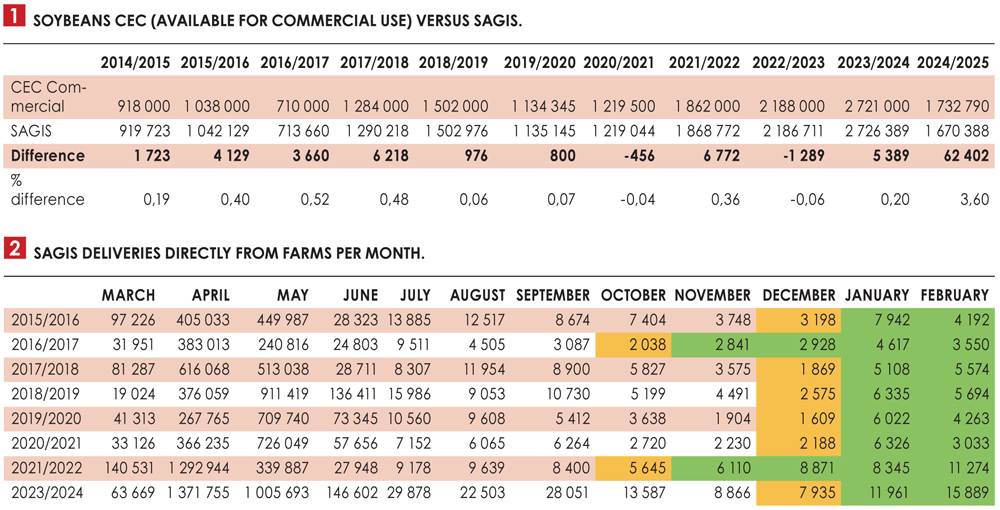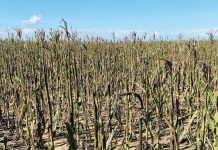
The matter of actual producer deliveries and the estimates provided by the Crop Estimates Committee (CEC) has always been a talking point and is, in some cases, still causing confusion within the industry. It is important to understand that the South African Grain Information Service (SAGIS) is mainly reporting on the historical movement of grain and/or oilseeds and is not involved in the crop estimations, which is a function of the relevant government department.
SAGIS is a not-for-profit company owned by various trusts – the Maize Trust, the Oil and Protein Seeds Development Trust, the South African Winter Cereal Industry Trust and the Sorghum Trust – and not a government entity. Various statutory measures requested by industry and approved by the Minister of Agriculture do, however, enable SAGIS to function in the correct manner by making it a requirement to submit data on a weekly and monthly basis.
SAGIS producer delivery data and the crop estimates
By reporting on the physical movement of soybeans, the producer deliveries directly from farms will be reported on the moment they are delivered at commercial premises. SAGIS therefore does not report on a specific season’s deliveries or allocate a specific season’s deliveries to a marketing year, but rather as and when grains or oilseeds are physically delivered at commercial premises, irrespective of the season it was planted and harvested in.
Currently SAGIS reports on soybean producer deliveries on a weekly as well as a monthly basis. The weekly producer deliveries contribute tremendously towards the estimation of the final crop, the quality of the crop (maize only) as well as the rate at which it is harvested and delivered.
Over the years the actual deliveries directly from farms to commercial premises came very close to the crop estimates. Table 1 is an indication of the difference between the final crop estimate estimated to be available for the commercial market and the actual deliveries reported by SAGIS.
From the 2014/2015 to the 2023/2024 marketing year the highest percentage difference between the actual producer deliveries and the crop estimates for soybeans available for the commercial market was 0,52%. That was during the 2016/2017 marketing year where the actual deliveries were 3 660 ton higher than the estimate. This difference is immaterial and compliments the accuracy of the final estimation by the CEC for the past ten years.
During the marketing years of 2015/2016, 2016/2017, 2017/2018, 2021/2022 and 2023/2024, SAGIS’ report was higher than the crop estimates. This might partly be due to early deliveries for the next season reported in the old season as it was delivered at the end of the old season. It could also have been soybeans kept on the farm for deliveries into the commercial market at a later stage in the season. As SAGIS does not report on the season in which the deliveries were planted, no distinction can be made for the differences.
This is also evident from Table 2, which indicates the tonnages delivered per month for each of the listed marketing years. The tonnages marked in green indicate an increase in monthly producer deliveries from the lowest point of deliveries in the marketing year marked in orange. It is also clear that December appears to be the most frequent month during which the lowest deliveries for the specified marketing years took place.
 Accuracy of SAGIS data
Accuracy of SAGIS data
SAGIS reports on the physical movement of grain. Any soybeans entering the commercial market will be reported on immediately by the commercial premises registered with SAGIS. Producer deliveries directly from farms will therefore be reported as soon as they are delivered at a commercial storage facility or any other premises such as a crushing facility. Exports directly from farms are also declared by the various traders involved. These are then recognised as producer deliveries as soon as they are exported.
Furthermore, each co-worker must declare what they’ve received on their premises or what was dispatched from their premises. The SAGIS information department reconciles these receipts and dispatches for all premises and will query and try to resolve any differences until all resources are depleted.
With these follow-up actions certain producer deliveries are then either verified or corrected according to the evidence obtained.
During this initial follow-up, incorrect data are identified and amended early in the process. This means that the inspection department does not have big corrections to make at a later stage in the marketing year.
Table 3 refers to the total receipts checked by the inspection department, including producer deliveries and receipts from other South African premises. The discrepancies found were immaterial and did not influence the data which were already published.
 Current marketing year
Current marketing year
For the current marketing year, the crop estimated to be available for the commercial market is 1 732 790 tons. For the week ending 26 July 2024, the progressive tonnage for soybeans already delivered directly from farms at commercial premises is 1 690 785 tons, which is 97,58% of the estimated crop. Another 42 005 tons or 2,42% must still be delivered to reach the crop estimate, with 30 weeks remaining for the marketing year to do so.



























